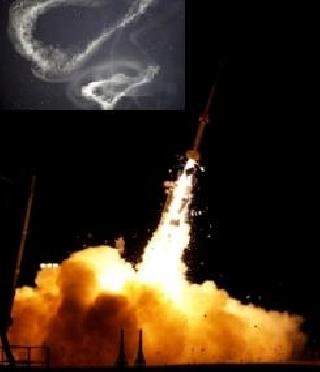
A suborbital rocket launches from the Wallops Flight Facility, Virginia, as part of NASA's ATREX mission. Five rocket launches leave a trail of white clouds (inset). NASA photo
WASHINGTON (BNS): US space agency NASA has launched five suborbital sounding rockets from the Wallops Island in Virginia on March 27.
The experimental rockets, called the Anomalous Transport Rocket Experiment (ATREX), were launched as part of a study of the upper level jet stream - a region of high speed winds over Earth's atmosphere.
The first rocket was launched at 4:58 am EDT (0858 GMT). Each subsequent rocket was launched in a quick succession of 80 seconds, the space agency said, adding that each of the rockets released a chemical tracer that created milky, white clouds at the edge of space.
The launches and clouds were reported to be seen in several parts of the country, allowing scientists and the public to "see" the winds in space.
Two of the rockets carried instrumented payloads to measure the pressure and temperature in the atmosphere at the height of the high-speed winds, NASA said.
The ATREX is a heliophysics sounding rocket mission that will gather information needed to better understand the process responsible for the high-altitude jet stream located 60 to 65 miles (97 to 104 kilometers) above the surface of the Earth, the space agency said.
The high-altitude jet stream is higher than the one commonly reported in weather forecasts. The winds found in the upper jet stream typically have speeds of over 300 mph (480 kph) and create rapid transport from the Earth's mid latitudes to the polar regions.
The jet stream is located in the same region where strong electrical currents occur in the ionosphere. It is therefore a region with a lot of electrical turbulence, of the type that can adversely affect satellite and radio communications.
 Next Article
Next Article













The Indian Air Force, in its flight trials evaluation report submitted before the Defence Ministry l..
view articleAn insight into the Medium Multi-Role Combat Aircraft competition...
view articleSky enthusiasts can now spot the International Space Station (ISS) commanded by Indian-American astr..
view article